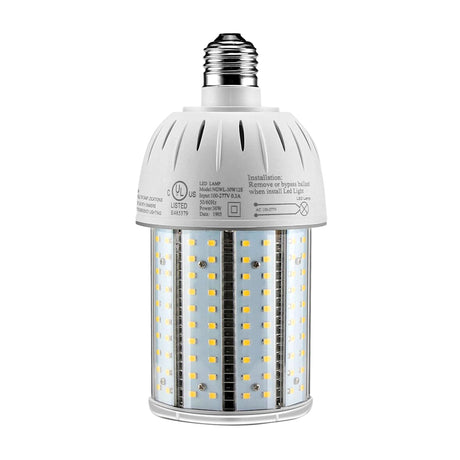LED Bulbs
LED bulbs are light bulbs that utilize light emitting diode technology. They consume less energy than traditional bulbs, have a lifespan of up to 25,000 hours, and generate so little heat that they don't need to be replaced as often. Our company offers a wide range of light bulbs, such as LED Corn Lights.
LED Light Bulbs Types
There are a lot of different types of light bulbs:
- LED Bulb of Corn
LED corn bulb is a special type of LED light with a cylindrical surface with rows of LED ribbons that combine to look very much like corn, and are therefore often called corn lights. These led corn light is known for their high brightness, energy efficiency and versatility, especially for industrial and outdoor environments.
What to Consider When Buying LED Light
Brightness (Lumen to Watt)
Lumens, as a unit, measure the actual light brightness, as opposed to watts units, which is a measure of energy consumption, which are not the same measurement. Also, the led bulb wattage and lumens are not exactly the same from one light to the next. An LED light bulbs uses fewer watts but still produces the same or higher lumens as an incandescent light, which means, as a high lumen led light bulbs, it will actually be brighter than incandescent light in the same wattage.
Therefore, before purchasing a led light bulb, check the lumens and recommended distance of the LED bulb led.
Color Temperature (Kelvins)
What are 5000k light and 6500k light? People often ask this question when they see labels for LED bulb LED. So what are they?
They are bulb color temperature, which is the color appearance of the light emitted by a light source and often affect the mood and ambiance of a space. Color temperature is measured in Kelvin (K).
Here are a few common LED light color temperatures to consider when making your purchase:
- 2700K to 3000K - Warm white light, similar to the light emitted by incandescent bulbs.
- 3500K to 4100K - Cool white light, providing a brighter, more neutral light for everyday use
- 5000K to 6500K - Similar to daylight, provides a very harsh “bleak white” light, more suitable for commercial or work areas.
Beam Angle
Beam angle is the angle of the beam in degrees that determines how much light is concentrated or spread out. For example, a narrow beam (30°) means that the light is concentrated at a specific point, while a wide beam (120°) spreads the light over a wider area. The maximum range of beam angles is 360°. So when buying LED lights you can decide which bulb to buy depending on the light beam angle and range of illumination required.
Fixture Compatibility
Make sure the size, shape and base type of the LED bulb matches the fixture (e.g. e26 bulb and e27 bulb). For all types of bulbs, we offer different sizes and wattage for those who need them. And some LED lamps are designed for specific fixtures, such as LED corn bulbs designed for industrial spaces. So when purchasing a bulb, make sure you know exactly what you're looking for in terms of the specifics of the bulb you want to buy.
Benefits of Switching to LED Light Bulbs
LED lighting provides many advantages over traditional lighting, such as incandescent lighting and fluorescent. To be more specific:
- Best Lights for Energy Efficiency:The most significant advantage is their superior energy efficiency, which allows them to deliver very high lumen at low wattage. And more importantly, LED lights consume at least 80% less energy, compared with old lights, which is a considerable savings on electricity bills, as a low cost high lumen lighting with low watt bulbs, especially where lighting is used for long time.
- Longer Life: LED lamp light bulb had a much longer lifespan compared to traditional bulbs. Instead of burning out with a tungsten filament, or exploding when the glass gets too hot, they gradually dim over time. This reduces the number of bulb replacements and lowers maintenance costs.
- Better Light Quality:Unlike traditional fluorescent lamps, they need to take time to reach full brightness. LED lights light bulbs can provide instant full brightness with no warm-up time. In addition, compared to incandescent lamps, these bright led light bulbs emit very little heat, and do not cause the temperature of the space to rise as the lamps are turned on for long time. At the same time, daylight LED bulbs have a high color rendering index (CRI), which means they display colors more accurately than other bulbs.
- Flexibility: LED lights also offer greater design flexibility and color options. LED lights bulbs come in a variety of shapes and sizes to fit a wide range of design applications, scenarios and locations. For example, LED corn lights are available in a variety of sizes and wattages to meet all lighting needs from small shopping centers to large warehouses with the brightest led bulb.
- Eco-Friendly:LEDs lights bulbs are environmentally friendly as they do not contain toxic substances such as mercury and are fully recyclable. In addition, LEDs have a long lifespan and low energy consumption, resulting in low carbon emissions and less landfill waste.

